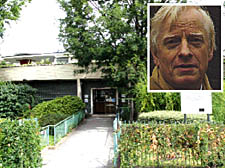|
|
 |
| |

Finsbury Health Centre; inset: James Dunnett |
Finsbury Centre campaign makes an appeal to history
Conservationists draw inspiration from spirit of Spanish revolution
ITS members were forced into exile by General Franco during the Spanish Civil War – many died on the battlefront fighting the fascist regime.
The firebrand Group of Catalan Architects and Technicians for the Progress of Contemporary Architecture was black-listed for creating public buildings that served the resistance and were later left to rot until the death of dictator in 1975.
Jose Luis Sert’s 1930s “Dispensari Central” in Barcelona – a visionary clinic that “democratised health care” at the time – has, since its restoration in the 1980s, become celebrated as an architectural symbol of the struggle for social justice.
Designed around the same time and with the same guiding principles as the Finsbury Health Centre in Pine Street – that “nothing is too good for ordinary people” – campaigners are hoping the romantic story of its restoration can persuade NHS Islington to “show some cultural awareness” and reverse its decision to sell Berthold Lubetkin’s Grade I-listed building to developers.
James Dunnett, co-chairman of the modernist architectural group Docomomo International, visited the Dispensary 10 years ago and was struck by its parallels with Finsbury.
He said: “The facilities built by the remarkable Metropolitan Borough of Finsbury ran concurrently to the public health and housing projects in Barcelona.
“The three major projects included the Dispensary and a Spanish Pavilion built for the 1937 Paris World Fair, for which Picasso painted the Guernica and where it was first exhibited.
“These buildings should not be seen in purely utilitarian terms. We at Docomomo-UK, with our colleagues in 53 countries, hope that the future of Finsbury Health Centre can be seen in the same way.”
Finsbury Health Centre, designed by visionary architect Lubetkin, opened in 1938 as the first publicly funded health centre in the country. It gave rise to the NHS and was described as “the pride of the borough” by the radical Finsbury Mayor of the day.
NHS Islington, which wants to sell it to a private developer because it is too expensive to repair, claims it should not be responsible for maintaining Islington’s architectural heritage.
It argues that its duty is to patient services and that the high cost of saving the centre would take away funding from the local health service.
Mr Dunnett added: “We have Grade I-listed buildings in Barts Hospital – but they are not being torn down. One of the reasons I keep harping on about this is that Paul Khan, chief executive of NHS Islington, is also chair of the Camden Arts Centre and ought to hold some cultural awareness. Simply to see it from an operational point of view is not good enough.”
Islington Council’s health and wellbeing committee is investigating the “future” of the health centre following after the secretary of state for health intervened in the decision making process.
Heritage of London Trust and English Heritage will be speaking in the Town Hall at 2pm on Wednesday October 7.
Mr Dunnett will talk about the Central Dispensary in Barcelona at a joint lecture to Islington Archaeology and History society in November 18. |
 |
|
|
 |
Your comments:
James Dunnet's lecture will be of great interest.Why is there no mention of time or venue for those not members of the Archaeological Society?
Adele Leffman
|
| |
|
 |
|